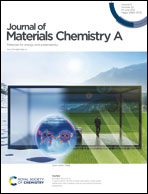Polyamide amine/aramid nanofiber composite aerogels as an ultra-high capacity adsorbent for Congo red removal†
Abstract
Industrial wastewater containing dyes has led to global water scarcity and been severely damaging to human health. The demand for the exploration of practical and cost-effective dye removal treatment is exploding. Here, we developed an ultrahigh-capacity adsorbent for dye removal, especially for Congo red. We synthesized a polyamide amine dendrimer aerogel based on aramid nanofibers (ANFs) through an effective method, which showed a specific area larger than the ANF aerogel by 38.1% due to the formation of polyamide amine dendrimer nanofibers bridging between ANFs. Moreover, the key mechanism of CR adsorption is changed from π–π stacking to H-bond interactions because of abundant N and O atoms in polyamide amine molecules, which make full use of the adsorbent surface space. As a result, the maximum of the CR adsorption capacity is 1957.881 mg g−1 and this value is still as high as 1567.063 mg g−1 even after five adsorption–desorption cycles. As we know, there are few reported adsorbents showing such high adsorption capacity for CR. And in a real wastewater system, the adsorption performance of CR changed slightly. Therefore, as an effective adsorbent, this composite nanofiber aerogel is very promising in the field of wastewater treatment.



 Please wait while we load your content...
Please wait while we load your content...